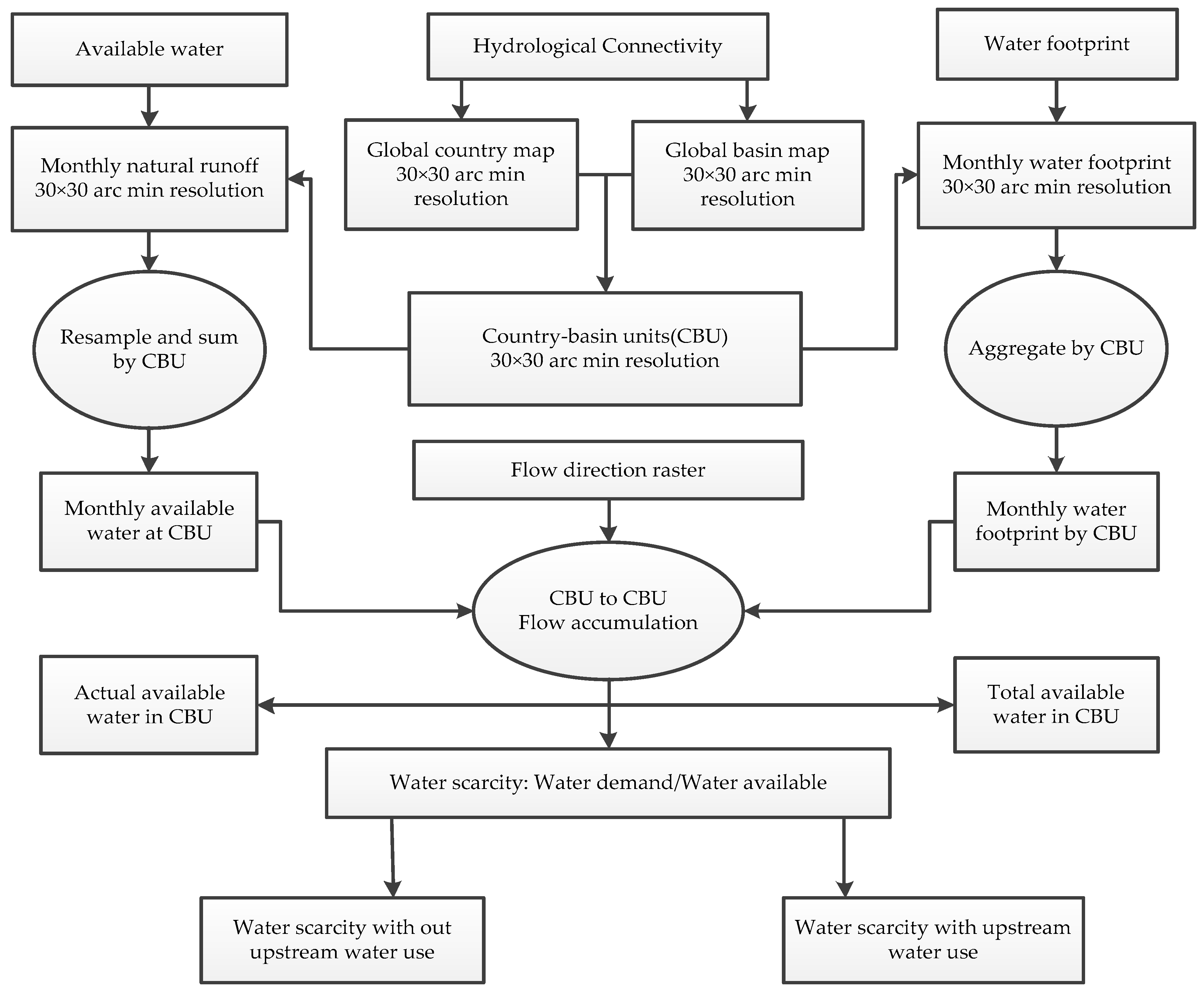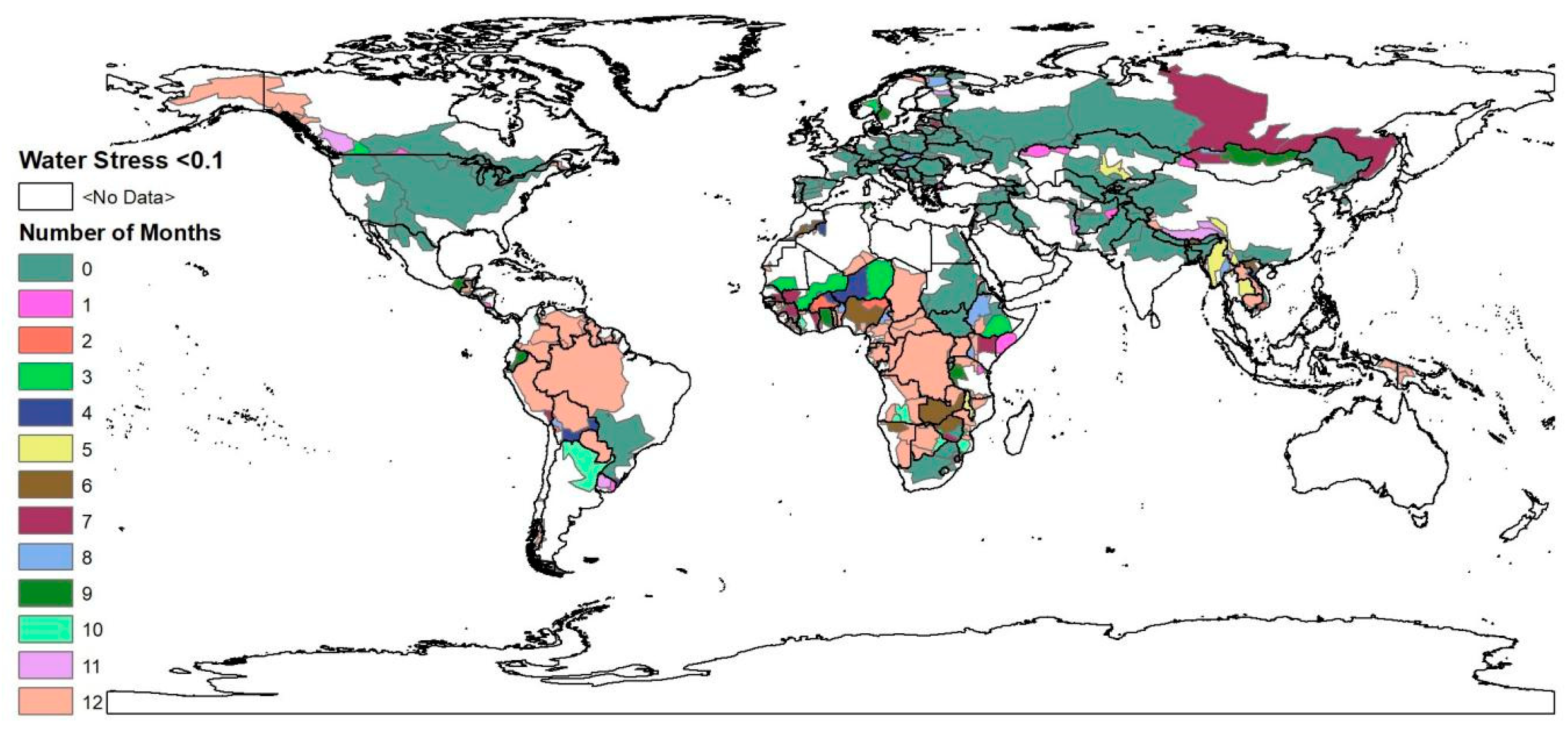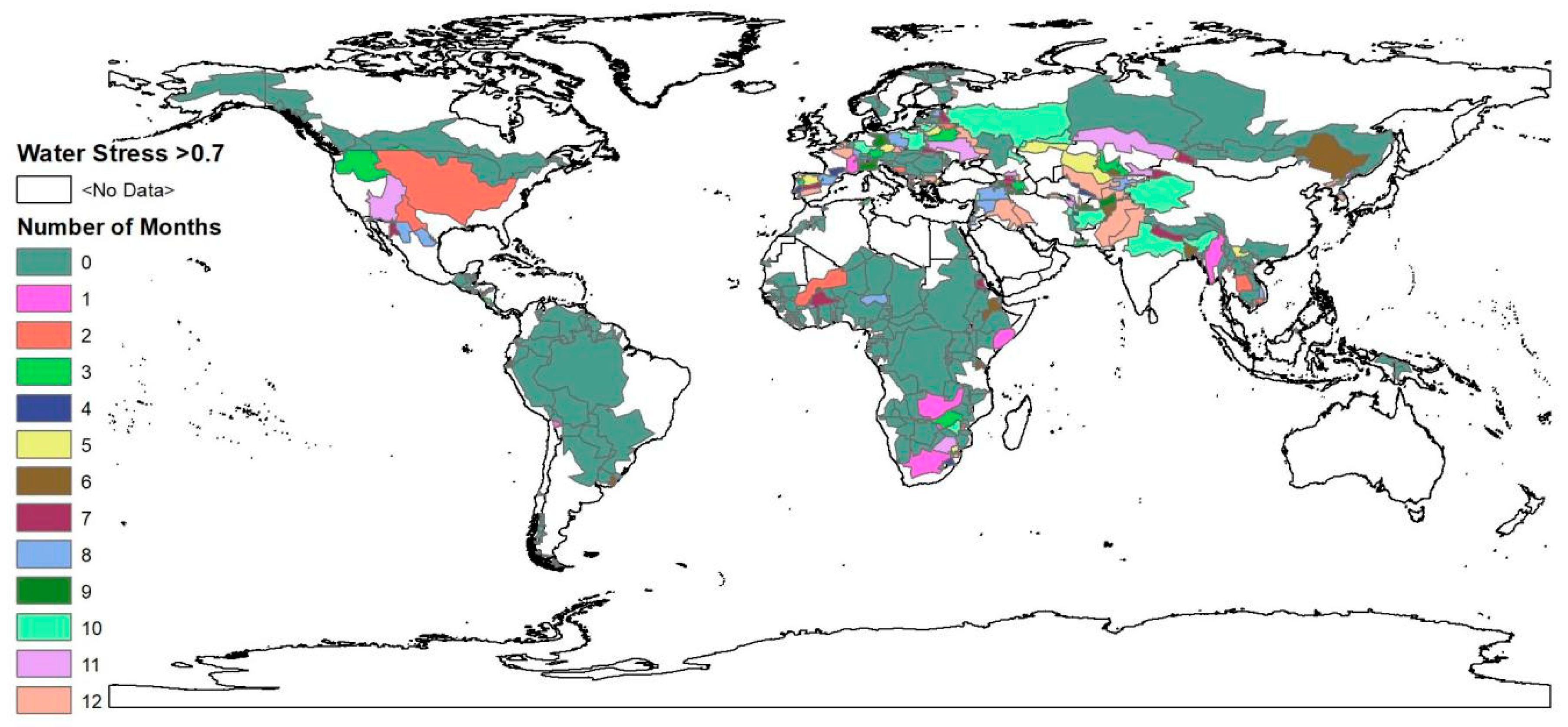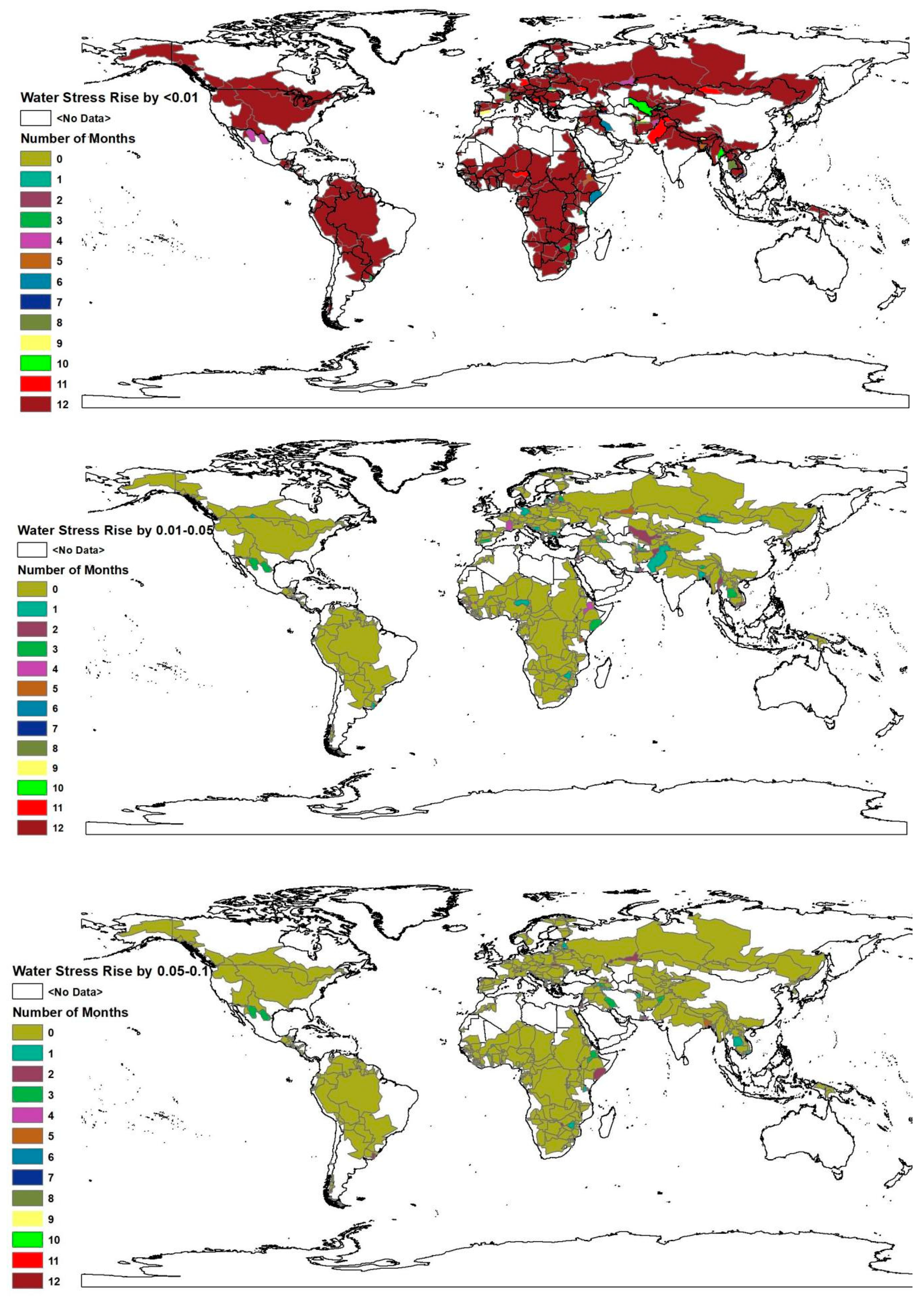The Impact of Upstream Sub-Basins’ Water Use on Middle Stream and Downstream Sub-Basins’ Water Security at Country-Basin Unit Spatial Scale and Monthly Temporal Resolution
Abstract
:1. Introduction
2. Materials and Methods
3. Results and Discussion
3.1. Water Stress under Absolute Territorial Integrity
3.2. Water Stress Intensification as the Result of Absolute Territorial Sovereignty
4. Conclusions
Supplementary Materials
Author Contributions
Funding
Acknowledgments
Conflicts of Interest
References
- Duran-encalada, J.A.; Paucar-caceres, A.; Bandala, E.R.; Wright, G.H. The impact of global climate change on water quantity and quality: A system dynamics approach to the US—Mexican transborder region. Eur. J. Oper. Res. 2017, 256, 567–581. [Google Scholar] [CrossRef]
- Zhang, X.W.J.; Wang, J.L.G. Water resources planning and management based on system dynamics: A case study of Yulin city. Environ. Dev. Sustain. 2011, 13, 331–351. [Google Scholar]
- Hoekstra, A.Y.; Mekonnen, M.M.; Chapagain, A.K.; Mathews, R.E.; Richter, B.D. Global monthly water scarcity: Blue water footprints versus blue water availability. PLoS ONE 2012, 7, e32688. [Google Scholar] [CrossRef] [PubMed]
- Mekonnen, M.M.; Hoekstra, A.Y. Four Billion People Experience Water Scarcity. Sci. Adv. 2016, 2, e1500323. [Google Scholar] [CrossRef] [PubMed]
- Munia, H.; Guillaume, J.H.A.; Mirumachi, N.; Porkka, M.; Wada, Y. Water stress in global transboundary river basins: Significance of upstream water use on downstream stress. Environ. Res. Lett. 2016, 11, 14002. [Google Scholar] [CrossRef]
- UN-Water. Transboundary Waters: Sharing Benefts, Sharing Responsibilities; UN-Water: Geneva, Switzerland, 2008. [Google Scholar]
- United Natons Environment Programme. Transboundary River Basins; United Natons Environment Programme (UNEP): Nairobi, Kenya, 2016. [Google Scholar]
- Ren, L.; Xue, L.-Q.; Liu, Y.-H.; Shi, J.; Han, Q.; Yi, P.-F. Study on variations in climatic variables and their influence on runoff in the Manas River basin, China. Water 2017, 9, 258. [Google Scholar] [CrossRef]
- Degefu, D.M.; Weijun, H.; Zaiyi, L.; Liang, Y.; Zhengwei, H.; Min, A. Mapping Monthly Water Scarcity in Global Transboundary Basins at Country-Basin Mesh Based Spatial Resolution. Sci. Rep. 2018, 8, 2144. [Google Scholar] [CrossRef] [PubMed]
- Ravnborg, M.H. Water and Conflict Prevention and Mitigation in Water Resources Management; Danish Institute for International Studies: Copenhagen, Denmark, 2004. [Google Scholar]
- Just, R.E.; Netanyahu, S. Conflict and Cooperation on Trans-Boundary Water Resources; Springer Science & Business Media: Berlin, Germany, 1998. [Google Scholar]
- Wolf, A.T. Criteria for equitable allocations: The heart of international water conflict. Nat. Resour. Forum 1999, 23, 3–30. [Google Scholar] [CrossRef]
- Vörösmarty, C.J.; Douglas, E.M.; Green, P.A.; Revenga, C. Geospatial Indicators of Emerging Water Stress: An Application to Africa. AMBIO Am. J. Hum. Environ. 2005, 34, 230–236. [Google Scholar] [CrossRef]
- Vörösmarty, C.J.; McIntyre, P.B.; Gessner, M.O.; Dudgeon, D.; Prusevich, A.; Green, P.; Glidden, S.; Bunn, S.E.; Sullivan, C.A.; Liermann, C.R.; et al. Global threats to human water security and river biodiversity. Nature 2010, 467, 555–561. [Google Scholar] [CrossRef] [PubMed]
- Alcamo, J.; Döll, P.; Henrichs, T.; Kaspar, F.; Lehner, B.; Rösch, T.; Siebert, S. Global estimates of water withdrawals and availability under current and future ‘business-as-usual’ conditions. Hydrol. Sci. J. 2003, 48, 339–348. [Google Scholar] [CrossRef]
- Munia, H.A.; Guillaume, J.H.A.; Mirumachi, N.; Wada, Y.; Kummu, M. How downstream sub-basins depend on upstream inflows to avoid scarcity: Typology and global analysis of transboundary rivers. Hydrol. Earth Syst. Sci. 2018, 22, 2795–2809. [Google Scholar] [CrossRef]
- Wada, Y.; Heinrich, L. Assessment of transboundary aquifers of the world—Vulnerability arising from human water use. Environ. Res. Lett. 2013, 8, 024003. [Google Scholar] [CrossRef]
- Hall, J.W.; Grey, D.; Garrick, D.; Fung, F.; Brown, C.; Dadson, S.J.; Sadoff, C.W. Coping with the curse of freshwater variability. Science 2014, 346, 429–430. [Google Scholar] [CrossRef] [PubMed]
- Wada, Y.; van Beek, L.P.H.; Viviroli, D.; Drr, H.H.; Weingartner, R.; Bierkens, M.F.P. Global monthly water stress: 2. Water demand and severity of water stress. Water Resour. Res. 2011, 47, 1–17. [Google Scholar] [CrossRef]
- Falkenmark, M.; Berntell, A.; Jägerskog, A.; Lundqvist, J.; Matz, M.; Tropp, H. On the Verge of a New Water Scarcity: A Call for Good Governance and Human Ingenuity; Stockholm International Water Institute: Stockholm, Sweden, 2007. [Google Scholar]
- Wada, Y.; Bierkens, M.F.P. Sustainability of global water use: Past reconstruction and future projections. Environ. Res. Lett. 2014, 9, 104003. [Google Scholar] [CrossRef]
- Fekete, B.M.; Vörösmarty, C.J.; Grabs, W. High-resolution fields of global runoff combining observed river discharge and simulated water balances. Glob. Biochem. Cycles 2002, 16, 151–156. [Google Scholar] [CrossRef]
- Richter, B.D.; Davis, M.M.; Apse, C.; Konrad, C. A Presumptive Standard for Environmental Flow Protection. River Res. Applic. 2012, 28, 1312–1321. [Google Scholar] [CrossRef]
- Center for International Earth Science Information Network—CIESIN—Columbia University. Gridded Population of the World, Version 4 (GPWv4): Population Count Adjusted to Match 2015 Revision of UN WPP Country Totals, Beta Release; NASA Socioeconomic Data and Applications Center (SEDAC): Palisades, NY, USA, 2015. [Google Scholar] [CrossRef]
- Environmental Systems Research Institute (ESRI). ArcGIS Desktop: Release 10.2; Environmental Systems Research Institute: Redlands, CA, USA, 2013. [Google Scholar]
- Oregon State University. Transboundary Freshwater Dispute Database (TFDD). Transboundary Freshwater Dispute Database (TFDD). 2007. Available online: http://transboundarywaters.orst.edu/ (accessed on 11 November 2018).
- Pacific Institute. Water Conflict Chronology; Pacific Institute: Oakland, CA, USA, 2009. [Google Scholar]
- Wolf, A.T.; Yoffe, S.B.; Giordano, M. International waters: Identifying basins at risk. Water Policy 2003, 5, 29–60. [Google Scholar]
- International Law Association. The Helsinki Rules on the Uses of the Waters of International Rivers. In Proceedings of the Report of the Fifty-Second Conference, Tokyo, Japan, 15–20 August 1966; pp. 484–532. [Google Scholar]






| Number of Months per Year | Number of People (in Millions) Experiencing Different Levels of Water Scarcity Intensification as the Result of Upstream Water Use | Number of Sub-Basins Experiencing Different Levels of Water Scarcity Intensification as the Result of Upstream Water Use | ||||||||
|---|---|---|---|---|---|---|---|---|---|---|
| 0–0.01 | 0.01–0.05 | 0.05–0.1 | 0.1–0.2 | >0.2 | 0–0.01 | 0.01–0.05 | 0.05–0.1 | 0.1–0.2 | >0.2 | |
| 0 | 28.6 | 2233.6 | 2474.92 | 2509.13 | 2638.7 | 16 | 468 | 517 | 521 | 516 |
| 1 | 9.34 | 318.9 | 54.3 | 168 | 3.76 | 5 | 37 | 28 | 29 | 12 |
| 2 | 3.59 | 63.77 | 23.09 | 28.11 | 29.56 | 7 | 21 | 14 | 9 | 13 |
| 3 | 6.24 | 59.9 | 44.32 | 7.95 | 0.73 | 6 | 21 | 8 | 8 | 4 |
| 4 | 21.77 | 26.2 | 0.35 | 3.37 | 7.03 | 9 | 10 | 1 | 4 | 5 |
| 5 | 137.68 | 7.47 | 119.37 | 0 | 2.09 | 7 | 6 | 1 | 0 | 5 |
| 6 | 21.4 | 0.3 | 0.22 | 0 | 9.31 | 6 | 3 | 2 | 0 | 3 |
| 7 | 18.24 | 0.73 | 0 | 0 | 0.9 | 6 | 2 | 0 | 0 | 3 |
| 8 | 31.42 | 0.43 | 0 | 0 | 4.89 | 9 | 1 | 0 | 0 | 3 |
| 9 | 19.82 | 5.28 | 0 | 0 | 0 | 13 | 1 | 0 | 0 | 0 |
| 10 | 34.6 | 0.003 | 0 | 0 | 5.7 | 15 | 1 | 0 | 0 | 4 |
| 11 | 199.52 | 0 | 0 | 0 | 0 | 30 | 0 | 0 | 0 | 0 |
| 12 | 2184.34 | 0 | 0 | 0 | 13.9 | 442 | 0 | 0 | 0 | 3 |
| Sum | 2716.56 | 2716.56 | 2716.56 | 2716.56 | 2716.56 | 571 | 571 | 571 | 571 | 571 |
© 2019 by the authors. Licensee MDPI, Basel, Switzerland. This article is an open access article distributed under the terms and conditions of the Creative Commons Attribution (CC BY) license (http://creativecommons.org/licenses/by/4.0/).
Share and Cite
Degefu, D.M.; Liao, Z.; He, W.; Yuan, L.; An, M.; Zhang, Z.; Xia, W. The Impact of Upstream Sub-Basins’ Water Use on Middle Stream and Downstream Sub-Basins’ Water Security at Country-Basin Unit Spatial Scale and Monthly Temporal Resolution. Int. J. Environ. Res. Public Health 2019, 16, 450. https://doi.org/10.3390/ijerph16030450
Degefu DM, Liao Z, He W, Yuan L, An M, Zhang Z, Xia W. The Impact of Upstream Sub-Basins’ Water Use on Middle Stream and Downstream Sub-Basins’ Water Security at Country-Basin Unit Spatial Scale and Monthly Temporal Resolution. International Journal of Environmental Research and Public Health. 2019; 16(3):450. https://doi.org/10.3390/ijerph16030450
Chicago/Turabian StyleDegefu, Dagmawi Mulugeta, Zaiyi Liao, Weijun He, Liang Yuan, Min An, Zhaofang Zhang, and Wu Xia. 2019. "The Impact of Upstream Sub-Basins’ Water Use on Middle Stream and Downstream Sub-Basins’ Water Security at Country-Basin Unit Spatial Scale and Monthly Temporal Resolution" International Journal of Environmental Research and Public Health 16, no. 3: 450. https://doi.org/10.3390/ijerph16030450
APA StyleDegefu, D. M., Liao, Z., He, W., Yuan, L., An, M., Zhang, Z., & Xia, W. (2019). The Impact of Upstream Sub-Basins’ Water Use on Middle Stream and Downstream Sub-Basins’ Water Security at Country-Basin Unit Spatial Scale and Monthly Temporal Resolution. International Journal of Environmental Research and Public Health, 16(3), 450. https://doi.org/10.3390/ijerph16030450







